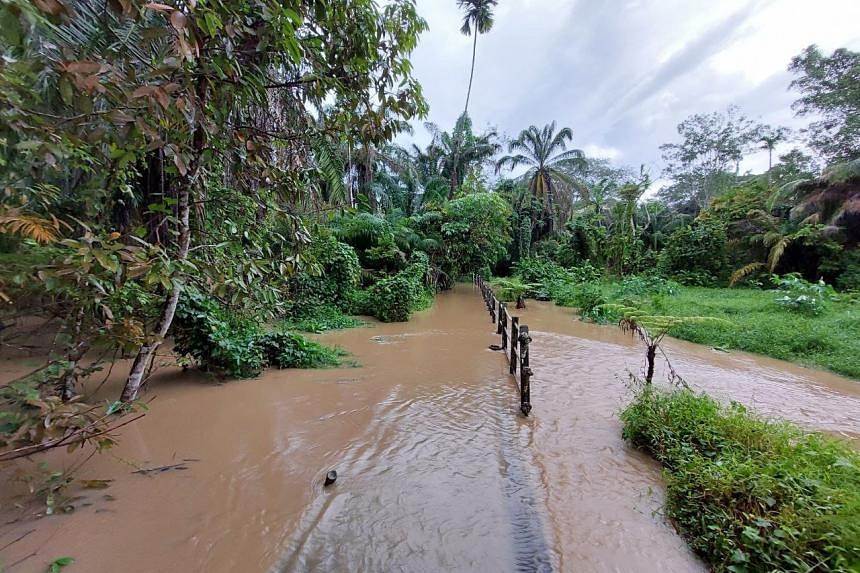SINGAPORE – Watch for storm clouds. Report potential dangers. Tell someone where you are headed.
These are some of the key precautions that seasoned hikers, bikers and nature guides are urging visitors to nature reserves and marine habitats to take amid wet weather and recent incidents.
On Jan 23, Mr Bucky Hussain and his two-year-old daughter fell through a hole in a bridge at Sungei Buloh Wetland Reserve.
The hole was caused by heavy rain and overflowing water during the peak of the spring tide, dislodging the floor panels. His wife and four-year-old son were unhurt.
Fortunately, Mr Hussain managed to hold his daughter above water and haul himself back onto the bridge, fighting strong currents.
The affected area was later cordoned off, and the hole was patched up after the water receded.
Separately, a portion of the Bukit Timah Mountain Bike Trail has been flooded for months due to wet weather partly caused by the north-east monsoon, which started in late November 2022.
Singapore experienced wet weather conditions for most months in 2022, with October recording the highest rainfall for that month in 42 years.
The National Parks Board (NParks) said the flooded zone on the mountain bike trail remains temporarily closed, with a sign informing cyclists to take an alternative route.
While the water is being pumped out, NParks is working with consultants to fix the issue.
Nature guides said most safety-related incidents occur during prolonged rainfall.
In November 2022, Mr Muhammad Nasry, executive director of the Singapore Youth Voices for Biodiversity, was alerted to a boardwalk in Windsor Nature Park that was submerged in flood waters and impassable.
The nature community has urged visitors to start monitoring the weather forecast at least two hours before the start of their hike using the National Environment Agency’s myENV app. It includes up-to-date information about an area’s weather, air quality and flood risk.
“Singapore is a tropical island, so storms are part and parcel of outdoor life here. During the monsoon, the myENV app is critical for tracking storm clouds and lightning,” said National University of Singapore biology lecturer N. Sivasothi, who runs tree-planting and habitat restoration efforts at Kranji Coastal Nature Park.
If a heavy downpour happens midway through a hike, nature guide Ivan Kwan of Nature Adventures SG will take his group to the nearest shelter or walk them to the park’s exit.
Singapore Cycling Federation vice-president (mountain bike) Muhammad Faroz Marzoki said: “Never take refuge under trees as they are prone to have deadfalls and rotten trees around which can collapse without telltale signs.”
Deadfalls refer to a mass of fallen branches and trees.
Ms Kong Man Jing, who runs intertidal walks and is a co-founder of science social media channel Just Keep Thinking, said of the case involving Mr Hussain and his daughter: “It is unfortunate that the dad and daughter had to go through the rather traumatic incident at Sungei Buloh. It is an incident that we should prevent at all costs. This was the first time that the bridge was affected by a heavy thunderstorm, so it was something unexpected.”
She added: “That being said, it is also impossible for every single area to be inspected 24/7, so I feel that it was really a case of just being at the wrong place at the wrong time.”

Some nature guides said it is unrealistic for all corners of a nature park or reserve to be monitored due to the vastness.
If visitors see faulty structures, flooded boardwalks or any potential hazards when park staff are not immediately available, they should submit a report on the OneService app – a platform that allows residents to provide feedback on municipal issues.
NParks’ noticeboard webpage also notifies visitors about closures or improvement works at specific areas.
Visitors could also alert others about hazards through social media groups.
Mr Nasry urges visitors not to create their own alternative pathways around a closed-off zone, citing the Dairy Farm Loop trail as an example.
He added that such alternative trails can damage the surrounding vegetation and destabilise the soil.
This can contribute to potential mudslides, which are known to occur in the Dairy Farm area, he warned.
But Mr Kwan said more staff should be available at nature reserves and other green spaces on weekends and public holidays when footfall is higher.
Ms Jagriti Dawra, executive director and head of environment at infrastructure consulting firm Aecom, said that with climate change expected to bring more erratic weather, the authorities and designers should take future impacts into account when designing and maintaining recreational areas.
“Management and maintenance should be conducted more regularly, especially during the monsoon seasons.
“I think areas should be designated ‘low risk’ to ‘high risk’ based on their vulnerability, exposure to extreme weather conditions and extent of use,” she added.


